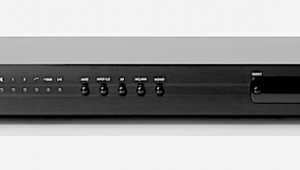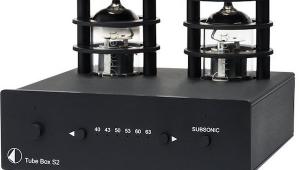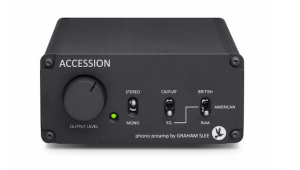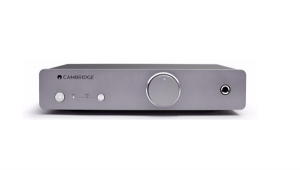Pass Aleph Ono phono preamplifier Page 2
Of equal importance to all of this tech talk and the fine set of numbers is the manual's claim that final decisions in the design, and changes made after the basic circuitry was configured, were based on listening-test results.
Mikey's listening tests
The Pass Aleph Ono was placed on a Z Slab platform set into the Zoethecus stand. I used both Black Diamond Racing Cones and Walker Valid Points and Tuning Discs underneath, and various AC cords and interconnects.
I began with the Parnassus D.C.t cartridge. After 24 hours of break-in with the Thor Audio Phono Burn, and without comparing the Ono to the phono section built into my new reference preamp, the Ayre K-1 (a FET-based, zero-feedback, balanced design), the Ono immediately impressed me with its high gain, no-noise performance.
As you might expect, the resolution of low-level detail was outstanding. Against a dead-black background, finely layered images floated in three dimensions on what was a somewhat wider soundstage than I'd become accustomed to. Image depth was not quite up to the best I've heard—the center image was moved slightly forward on familiar recordings—but the overall sonic picture possessed the kind of bold, visceral energy, transparency, and image solidity I crave.
In preparation for the Fall 1998 issue of The Tracking Angle, which featured the best live recordings, I played everything I could dig up, including Frank Sinatra's At the Sands (Reprise 2FS 1019), Nat King Cole's At the Sands (Capitol SMAS 2434), Little Feat's Waiting for Columbus (Mobile Fidelity MFSL2-013), Joan Baez' In Concert (Vanguard 2122), and other familiar favorites. The Pass's resolution of ambient cues, and the overall delineation of the actual event and its reverberant aftermath, were first-rate. The excitement of the live performances and the sense of "being there" were fully developed.
Tonally, the Aleph Ono immediately struck me as somewhat lacking in lower-midbass weight and authority, though the very bottom was well extended and reasonably firm. Whether it was because of the midbass character or not, the midrange seemed slightly underdeveloped and lacking in richness compared to what I'd become used to. The upper midrange seemed essentially correct, with a nice, open, transparent window that was never harsh or edgy. While the very top end was open and extended, the last bit of air and shimmer seemed absent compared to the best I've heard. But I preferred that to hard and grainy, neither of which the Aleph Ono ever was.
Dynamically, the Aleph Ono was unrestrained, delivering orchestral crescendos with complete authority—competitive with the best. It also rendered with ease the low-level microdynamic gestures that give music a sense of the "real," and that CD processors don't seem to deliver at any price. Not surprisingly, the Aleph Ono loosed fast, highly resolved transients, which helped give all genres of music a taut, rhythmic drive. The Aleph Ono delivered a "gelled," consistent sound that was never less than exciting. I found myself listening for hours at a time during the first week or so—always a good sign.
Those were first-round impressions using Black Diamond Racing Cones, an Electra-Glide Reference AC cord, a set of Magnan Vi interconnects, and 100 ohm loading. Then I substituted a Yamamura Quantum AC cord. That increased the richness in the midband somewhat, but slightly lowered the macrodynamic ceiling and definitely lightened the pitch-black background. Substituting Walker Valid Points for the Black Diamond Racing Cones added a bit of bloom to the midrange. I tried a variety of high-quality interconnects, but while I could shift the balance slightly one way or the another, the Aleph Ono's strengths and weaknesses remained.
All of these subtle but significant changes helped to flesh out the pristine but somewhat thin midrange, adding needed harmonic body to the tonal picture. Nothing I tried added midbass weight, nor could I add the last bit of air on top—even with wide-open 47k-ohm loading. Keep in mind that the Audio Physic Virgos are somewhat warm in the midbass to begin with, and not the last word in high-frequency extension, though they do sound quite open and ultra-detailed. I also tried some older Cardas balanced cables I had on hand; aside from the added gain, I heard no significant tonal or spatial difference.
Ultimately, I felt the Aleph Ono's performance was optimized with the Magnan interconnect, the Electra-Glide AC cable, 100 ohm loading (with the Parnassus D.C.t), and the Walker Valid Points. That combination emphasized the Ono's strong points: jet-black backgrounds, unrestrained dynamics, transparency, soundstage width, transient speed and focus, and rhythmic excitement. (It's a testament to the high performance of the Aleph Ono that these substitutions yielded such easily audible changes.)
I performed a series of A/B comparisons with the Ayre K-1's built-in phono stage, and the differences were consistent: The Aleph Ono delivered a somewhat wider soundstage, the Ayre a deeper one. This, I concluded, was due more to tonal differences between the two than to anything else. The Ayre's midbass and midrange were richer and more fully fleshed out; the very bottom, too, had somewhat more solidity and impact, the top somewhat more extension.
I did these comparisons using the Transfiguration Temper, the AudioQuest Fe5, and the Grado Reference (in MM mode) cartridges. The richer-sounding Grado and Fe5 made a better match with the Aleph Ono, but the overall balance held.
How does this translate into actual music? I knew you'd ask! On "Carey" on Joni Mitchell's Blue (Reprise MS 2038), for example, the congas have a bit more "skin" and body through the Ayre, and the background vocals seem farther back in the soundstage. Mitchell's voice has somewhat more chest to it. The Aleph Ono separated the images a bit better, but I attribute that to its midbass performance. These were all subtle (though not insignificant) differences.
Conclusion
The $2000 Pass Aleph Ono is a superbly built, well-balanced performer that, despite a few minor shortcomings, gets most of the sonic picture correct. Without comparison to my reference—part of a $7100 preamp—I felt the Aleph Ono could satisfy my listening needs for a very long time. With the exception of its somewhat deficient and perhaps mushy lower midbass, which gives the Ono an overall lean sound, the other differences I noted are subtle, and perhaps more system-dependent than anything else.
Clearly, the Aleph Ono comes from the more detailed, analytical side of the musical tracks, and lacks the rich, bloomy sound some of you might prefer. Still, it sounds smooth, never hard or etchy. It will appeal less to classical-music lovers and more to pop, rock, and jazz fans, I think. But unless you're committed to tubes, and even if your collection is all classical, don't write off this extremely flexible, ultra-low-noise, high-gain, superbly designed and built, and very reasonably priced product. Go listen for yourself.
Footnote 1: Audio Electronics is published by Audio Amateur Corporation, PO Box 876, Peterborough, NH 03458-0876. Tel: (603) 924-9464. Fax: (603) 924-9467.
- Log in or register to post comments

















































